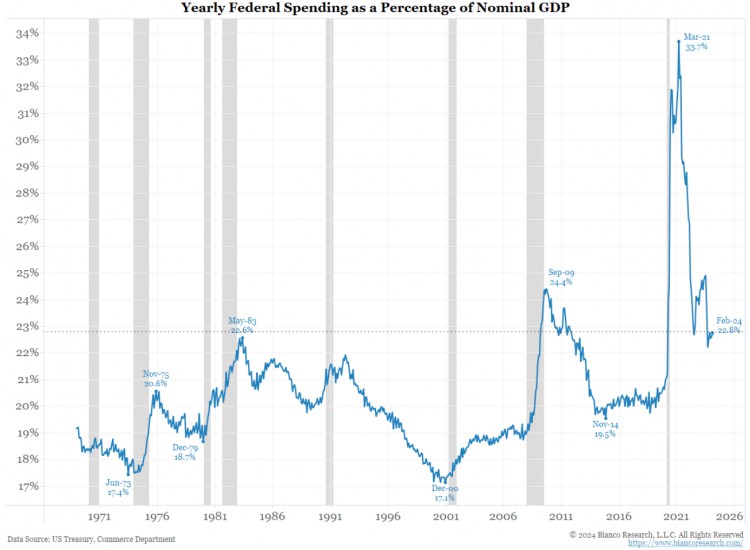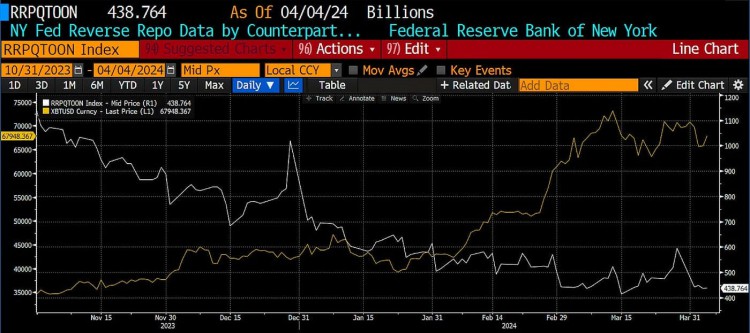原標題:熱浪
原作者:阿瑟·海耶斯
原始來源:Medium
編譯:Lynn、火星財經
(以下任何觀點均屬作者個人觀點,不應構成投資決策的依據,也不應被視為從事投資交易的推薦或建議。)
繁榮!
繁榮!
繁榮!
這是手機提醒我的北海道各滑雪場夜間降雪的聲音。雖然這個聲音在一月和二月給我帶來了巨大的快樂,但在三月,它只帶來了 FOMO。
從三月初開始,過去幾個賽季我一直在北海道滑雪。我最近的經歷告訴我,大自然在 3 月 1 日左右開始升溫。我是滑雪初學者,只喜歡最乾燥、最深的斜坡。然而,這個賽季,蓋亞發生了巨大的變化。二月有一場殘酷的暖流,驅散了積雪。直到月底,寒冷的天氣才再次出現。但三月氣溫又回來了,每晚都會傾倒 10 至 30 公分的新鮮戰俘。這就是我手機爆炸的原因。
整個三月,我坐在東南亞各個炎熱潮濕的國家,愚蠢地檢查應用程序,破壞了我離開滑雪場的決定。四月的解凍終於真正發生了,我的 FOMO 也隨之結束了。
正如讀者所知,我的滑雪經驗是我的宏觀和加密貨幣交易書籍的隱喻。我之前寫過,3月12日美國銀行定期融資計畫(BTFP)終止將導致全球市場暴跌。 BTFP 被取消,但加密貨幣領域的惡性拋售並未發生。比特幣果斷突破 7 萬美元,最高達到 7.4 萬美元左右。 Solana 繼續與各種小狗和小貓模因幣一起上漲。我的時機不對,但就像滑雪季節一樣,三月出乎意料的有利條件不會在四月重演。
雖然我喜歡冬天,但夏天也帶來歡樂。北半球夏季的到來為我帶來了運動的樂趣,我重新安排了時間去打網球、衝浪、風箏衝浪。由於聯準會和財政部的政策,夏季將迎來新的法幣流動性湧入。
我將簡要概述我的心智圖,說明風險資產市場將如何以及為何在四月經歷極度疲軟。對於那些有足夠勇氣做空加密貨幣的人來說,宏觀環境是有利的。雖然我不會直接做空市場,但我已經關閉了幾個垃圾幣和迷因幣交易頭寸並正在獲利了結。從現在到 5 月 1 日,我將處於禁止交易區。我希望在五月帶著乾粉回來,做好部署準備,為牛市的真正開始做好準備。
詐欺罪
The Bank Term Funding Program (BTFP) ended a few weeks ago, but the US Too Big to Fail (TBTF) banks have not faced any real stress subsequently. This is because the high priests of Fugazi finance have a series of tricks they will use to secretly print money to bail out the financial system. I will peek behind the scenes and explain how they are expanding the US dollar fiat money supply, which will support the general rise of cryptocurrencies and stocks until the end of the year. While the end result is always money printing, the process is not without periods of slow liquidity growth, which provide negative catalysts for risk markets. By carefully studying this series of tricks and estimating when the rabbit will be pulled out of the hat, we can estimate when there will be periods when free markets are allowed to operate.
Discount Window
The Federal Reserve and most other central banks operate a facility called a discount window. Banks and other covered financial institutions that need funds can pledge eligible securities to the Fed in exchange for cash. In general, the discount window currently only accepts U.S. Treasury securities (UST) and mortgage-backed securities (MBS).
Suppose a bank is screwed because a bunch of Pierce and Pierce baby boomer stooges are running it. The USTs held by the bank were worth $100 when purchased, but are currently worth $80. The bank needs cash to meet the deposit outflow. An insolvent shit bank can tap the discount window instead of declaring bankruptcy. The bank exchanges the $80 UST for $80 in dollar bills because under current rules the bank receives the market value of the pledged securities.
In order to abolish BTFP and remove the associated negative stigma without increasing the risk of bank failure, the Fed and the U.S. Treasury now encourage troubled banks to use the discount window. However, under current collateral terms, the discount window is not as attractive as the recently expired BTFP. Let's go back to the example above to understand why.
Remember, the value of the UST fell from $100 to $80, which means the bank has an unrealized loss of $20. Initially, $100 of UST was backed by $100 of deposits. But now the UST is worth $80; therefore, if all depositors flee, the bank will be short $20. Under the BTFP rule, the bank receives the par value of the underwater UST. This means that $80 worth of UST is redeemed for $100 in cash when it is delivered to the Fed. This restores the bank's solvency. But the discount window only provides $80 for the $80 worth of UST. The $20 loss remains, and the bank remains insolvent.
Given that the Fed can unilaterally change collateral rules to balance the treatment of assets by BTFP and the discount window, the Fed continues its invisible bank bailout by giving the insolvent banking system a green light to use the discount window. Thus, the Fed essentially solves the BTFP problem; the entire UST and MBS balance sheet of the insolvent US banking system (which I estimate at $4 trillion) will be available to support lending when needed with funds printed from the discount window. This is why I believe that the market did not force any non-TBTF banks into bankruptcy after the BTFP ended on March 12.
Bank capital requirements
Banks are often called upon to finance governments that issue bonds at yields below nominal GDP. But why would private for-profit entities buy something that has a negative real yield? They do so because bank regulators allow banks to buy government bonds with little or no down payment. When banks that have insufficient capital buffers against their government bond portfolios inevitably collapse as inflation sets in and bond prices fall as yields rise, the Fed allows them to use the discount window in the manner described above. As a result, banks would rather buy and hold government bonds than lend to businesses and individuals who need funds.
When you or I buy anything with borrowed money, we have to pledge collateral or equity to cover potential losses. That's prudent risk management. But if you're a vampire squid zombie bank, the rules are different. After the 2008 global financial crisis (GFC), world bank regulators sought to force global banks to hold more capital, thereby creating a more robust and resilient global banking system. The system of rules that codified these changes is called Basel III.
The problem with Basel III is that government bonds are not treated as risk-free. Banks are required to post a small amount of capital for their large sovereign bond portfolios. These capital requirements have proven to be problematic in times of stress. During the COVID-19 market crash in March 2020, the Fed decreed that banks could hold USTs without collateral backing them. This allowed banks to step in and store trillions of dollars worth of USTs in a risk-free manner… at least in accounting terms.
When the crisis abated, the supplementary leverage ratio (SLR) exemption for USTs was restored. Predictably, as UST prices fell due to inflation, banks went bankrupt due to insufficient capital buffers. The Fed came to the rescue through BTFP and now the discount window, but this can only make up for the losses caused by the last crisis. How can banks step up and absorb more bonds at the current unattractive high prices?
The U.S. banking system loudly proclaimed in November 2023 that Bud Gur Yellen couldn’t stuff more bonds at them because Basel III forced them to hold more capital in their government bond portfolios. So something had to give because the U.S. government had no other natural buyers for its debt at a time of negative real yields. Here’s how the banks politely expressed their precarious situation.
Demand for Treasuries from some traditional buyers may have softened. Bank portfolio assets have been falling since last year, with banks holding $154 billion less in Treasuries than a year ago.
Source: Report of the Treasury Borrowing Advisory Committee to the Secretary of the Treasury
Once again, the Fed, led by Powell, saved the day. At the recent US Senate banking hearing, Powell suddenly announced that banks would not be subject to higher capital requirements. Remember, many politicians called on banks to hold more capital to avoid a repeat of the regional banking crisis of 2023. Apparently, the banks lobbied hard to remove these higher capital requirements. They had a good argument - if you, Bad Gurl Yellen, want us to buy shit government bonds, then we can only make money with unlimited leverage. Banks around the world manage all types of governments; the US is no exception.
The icing on the cake is the recent letter from the International Swap Dealers Association (ISDA) advocating for an exemption for USTs from the SLR I talked about earlier. Essentially, if banks are not required to make any down payments, they are left holding trillions of dollars in USTs to finance the US government deficit on a future basis. I expect the ISDA proposal to be accepted as the US Treasury ramps up debt issuance.
 This excellent chart from Bianco Research clearly shows how wasteful the US government is, as evidenced by record high deficits. The two most recent periods of higher deficit spending were the 2008 global financial crisis and the baby boomer-led COVID-19 lockdowns. The US economy is growing, but the government is spending like it’s in a recession.
This excellent chart from Bianco Research clearly shows how wasteful the US government is, as evidenced by record high deficits. The two most recent periods of higher deficit spending were the 2008 global financial crisis and the baby boomer-led COVID-19 lockdowns. The US economy is growing, but the government is spending like it’s in a recession.
In summary, the easing of capital requirements and the possible future exemption of UST from SLR is a covert form of money printing. The Fed does not print money, but the banking system creates credit money out of thin air and buys bonds, which then appear on its balance sheet. As always, the goal is to ensure that government bond yields do not rise above nominal GDP growth. As long as real interest rates remain negative, Stokes, cryptocurrencies, gold, etc. will continue to rise in price in fiat currencies.
Bad Gurl Yellen
My article “Bad Gurl” dives into how the U.S. Treasury, led by Bad Gurl Yellen, is increasing the issuance of short-term Treasury bills (T-bills) to exhaust the trillions of dollars locked up in the Fed’s reverse repo program (MSRP). As expected, the decline in the MSRP coincided with a rally in stocks, bonds, and cryptocurrencies. But now that the MSRP has fallen to $400 billion, the market is wondering what the next source of fiat liquidity will be to boost asset prices. Don’t worry, Yellen isn’t done yet, yelling “the loot is about to drop.”
RRP balance (white) and Bitcoin (yellow)
 The fiat flows I will discuss focus on U.S. tax payments, the Federal Reserve’s quantitative tightening (QT) program, and the Treasury General Account (TGA). The timeline in question is from April 15 (the tax due date for the 2023 tax year) to May 1.
The fiat flows I will discuss focus on U.S. tax payments, the Federal Reserve’s quantitative tightening (QT) program, and the Treasury General Account (TGA). The timeline in question is from April 15 (the tax due date for the 2023 tax year) to May 1.
Let me help you understand what these three things mean by providing a quick guide to their positive or negative impact on liquidity.
Paying taxes removes liquidity from the system. That’s because taxpayers have to take cash out of the financial system, such as by selling securities, to pay their taxes. Analysts expect tax payments to be high for the 2023 tax year, due to large interest income and a solid stock market.
QT removes liquidity from the system. As of March 2022, the Fed allowed about $95 billion worth of USTs and MBS to mature without reinvesting the proceeds. This caused the Fed's balance sheet to decline, which, as we all know, reduces USD liquidity. However, what we care about is not the absolute level of the Fed's balance sheet, but the pace of its decline. Analysts such as Joe Kalish of Ned Davis Research expect the Fed to reduce the pace of QT by $30 billion per month at its May 1 meeting. The slower pace of QT is good for USD liquidity as the Fed's balance sheet declines at a slower pace.
When the TGA balance goes up, it removes liquidity from the system, but when the TGA balance goes down, it adds liquidity to the system. The TGA balance goes up when the Treasury receives tax payments. I expect the TGA balance to be well above its current level of about $750 billion as the tax payments are processed on April 15. This is negative dollar liquidity. Don’t forget that this is an election year. Yellen’s job is to get her boss, U.S. President Joe Bolden, re-elected. That means she has to do everything she can to stimulate the stock market, make voters feel rich, and attribute this great outcome to the “genius” of slow Bidennomics. When the RRP balance finally drops to zero, Yellen will spend the TGA, likely releasing an additional $1 trillion in liquidity into the system, which will boost the market.
風險資產的波動期為4月15日至5月1日。此時,納稅消除了系統的流動性,QT繼續以目前的高利率運行,而耶倫尚未開始減少TGA。 5月1日後,QT放緩,耶倫忙著兌現支票,推高資產價格。如果您是交易者,正在尋找合適的時機進入無恥的空頭頭寸,那麼四月是最好的時間。 5月1日之後,一切又恢復如常……聯準會和美國財政部的金融惡作劇引發了資產通膨。
比特幣減半
比特幣區塊獎勵預計將於 4 月 20 日減半。這被視為加密貨幣市場的看漲催化劑。我同意這將在中期內推高價格;然而,之前和之後的價格走勢可能是負面的。減半對加密貨幣價格有利的說法已經根深蒂固。當大多數市場參與者就某個結果達成一致時,通常會發生相反的情況。這就是為什麼我相信比特幣和加密貨幣價格總體會在減半前後暴跌。
鑑於減半發生在美元流動性比平常更緊張的時候,這將加劇加密資產的拋售狂潮。減半的時機進一步加劇了我在五月之前放棄交易的決定。
到目前為止,我在 MEW、SOL 和 NMT 的這些職位上已經獲得了全額利潤。所得收益存入 Ethena 的 USDe 並質押以賺取巨額收益。在 Ethena 之前,我持有 USDT 或 USDC,卻一無所獲,而 Tether 和 Circle 卻獲得了全額國債收益率。
市場能否克服我的看跌偏見並持續走高?他媽的是的。我一直是加密貨幣的忠實粉絲,所以我歡迎犯錯。
當我在 Token2049 Dubai 上兩步走的時候,我真的想照顧我最具投機性的垃圾幣頭寸嗎?一定不行。
所以,我甩了。
沒有必要悲傷。
如果我上面討論的美元流動性情景成為現實,我將更有信心模仿各種狗屎。如果我錯過了幾個百分點的收益,但絕對避免了我的投資組合和生活方式的損失,那是一個可以接受的結果。就這樣,我向你告別了。記得穿上舞鞋,我們將在杜拜與您見面,慶祝加密貨幣牛市。
